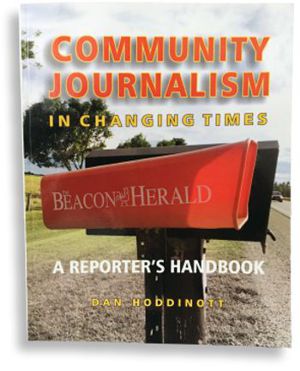What type of journalism?
How knowing this can help you determine where your content should meet its audience
By DAN HODDINOTT
Some time ago I was sitting in the office of a newspaper publisher, going over some issues he was facing related to the fracturing of his readership from a once-solid newspaper base to one splintered over multiple, largely digital platforms. His attachment to the print edition was nostalgic as much as practical, except for his firm recognition of the print edition as still the primary revenue-generating vehicle. We talked along those lines for a while, and suddenly the light bulb came on. Which one of us could claim credit for flipping the switch is irrelevant.
I ASK A VERY BASIC QUESTION at every newspaper I visit, regardless of what role I’m proposing to play there (if there’s even a role on the table at all). It is this: “What type of journalism do we pursue here?”
Is it standard “reactionary” journalism — the type that reacts to prompts; reporting on events having taken place and heralding upcoming activities to which the newspaper has been alerted? Is it activist instead? Social justice oriented? Political, perhaps?
Not that the correct answer is necessarily found in selecting from these few options. Quite frankly, it probably matters less what your call to arms might be than that you know precisely what product you produce, and why. Every type of content is best suited to a particular publishing platform and, in turn, appeals to a knowable segment of the over-all content-consuming public. To be oblivious to the voracious public appetite for meaningful content and to the proper pairings of content type and platform is to miss out on a raft of maximums available for the picking.
Relevance is where it’s at in these times. How relevant is your stance relative to the position the readers you pursue now occupy on the spectrum that you share? Have their preferences and expectations changed any, or are they in the same place they were before technology and drastic social change came along to root you out of your comfort zone? Are you able to reconnect with them in satisfactory numbers? Are you able to command attention, and make your brand visible in their everywhere?
I’ve seen some traditional weekly newspapers abandon the active pursuit of news in favour of less time-sensitive content, and do so with a measure of success. They have recognized a valuable truth: in a connected world the weekly print edition is hardly functional as a newspaper anymore. It informs, but seldom breaks news; it’s likely readers have already consumed the actual that-it-happened news portion of the story before the paper is even off the press. The focus in these newsrooms has shifted to what to inform the reader about, and how best to distribute that information in a timely fashion.
Successful newspapers also recognize the print edition is still the primary revenue-generating vehicle, of course, so endeavour to keep it relevant by reimagining the content the newsroom generates and redistributing “hot” news elements among the digital output streams.
The digital era is a godsend to the community journalist passionate about efficient news publishing, thank you very much! Expect no lamentations here bemoaning the passing of a print-only world.
In an overarching sense, all of the newspaper's output streams reflect a unified approach to the journalism model management has settled on — be that political, activist, social or traditional news. Community newspapers almost always carry on the tradition of evenhanded, reactionary news coverage, even where championing of hometown people, values and causes is the trademark. Their relevance has not waned due to the busy-ness, speed or scope of digital media consumption; local people will always have an appetite for information about the mechanics of life’s workings in the place where they live. How relevant the local newspaper continues to be is commensurate with how it chooses to distribute elements of its coverage among available platforms.
Distributing content appropriately across platforms
You’re relevant as long as you satisfy someone’s desire to know, and meet reader expectation in the doing.
Breaking news, presented as such, has little impact emblazoned across the front page of the weekly newspaper, for example, unless the stars have all aligned just so and the story is only hours, not days, old. In the digital age, no one “finds out” about an earthshaking event days later. Day-old news is about as appetizing in this reading milieu as day-old bread at a banquet for the queen. The solution: break the news on your app, the website and on any other digital platform where readers expect to see you, and let them expect to see drilldown expository coverage in the actual paper when it comes out.
The paper product requires the nourishment of digital and online promotion, it's worth noting.
There is an ideal balance to be struck between what you rush out onto digital platforms and what goes into the paper. Readers of app-based digital content are looking to be informed, but briefly so; lengthy magazine-style reads enjoyed online are generally sought out separately, in a different circumstance, and are prompted by a desire to acquire a different level of information. The print edition offers latitude to you to offer more and is a medium where the parameters are known at a glance, thus permitting the reader to engage or not engage without threat of being pulled into an unnavigable wilderness.
A staple of community journalism is coverage of municipal government and community meetings, often made long by description of interplay and dialogue between participants. These stories don’t readily translate to most digital streams, where brevity is the expectation and an abundance of non-urgent information tends to clog things up. The outcome of the event, placed in context, often gets the job done; add a pointer to where the reader can expect to find the full story. The details of the actual event, along with the colour and the drama, can be better accommodated and appreciated on the website and in the paper.
So, what type of journalism do we pursue here? The answer should be: as before, what the readership expects of us, distributed according to reading expectations.


